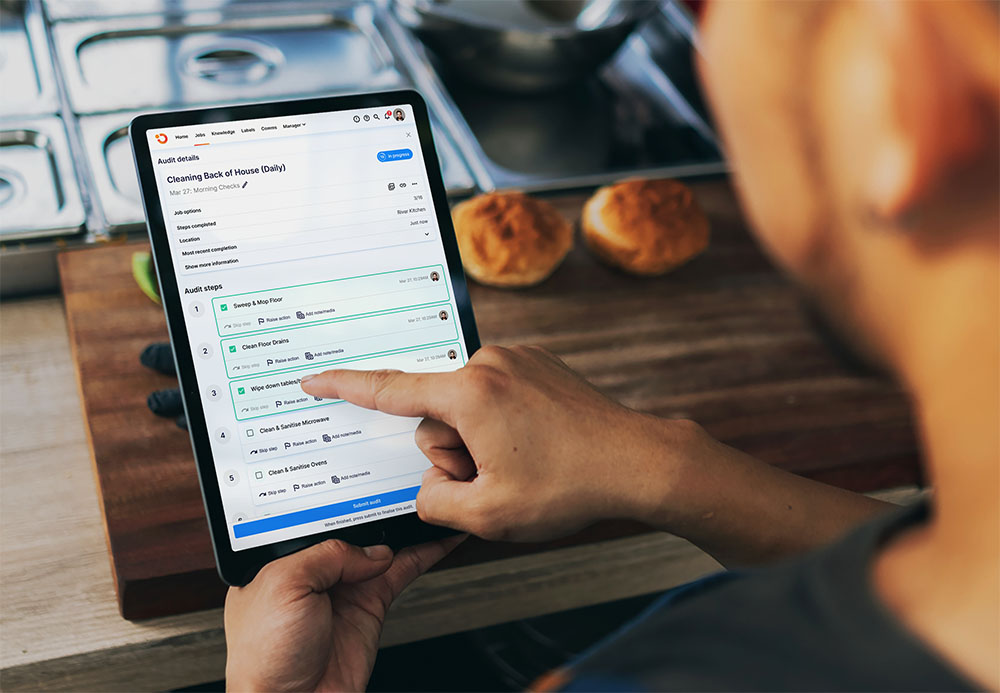Food industry compliance management: Best practices & tools
Managing compliance in the food industry can feel like an endless challenge. With food safety to maintain, constantly shifting regulations, and the need for consistent operations, it’s easy to get overwhelmed.
But compliance isn’t just a legal box-ticking exercise — it’s about safeguarding your customers and building trust in your brand.
In this article, we’ll break down the best practices for compliance management, offering actionable tips to help you keep on top of them (and keep your business running smoothly).
An overview of food industry compliance
Food industry compliance refers to the adherence to laws, regulations, and standards set by local, state, and federal authorities to ensure the safety and quality of food.
These regulations cover many areas, including food safety hazards, sanitation, employee training, and record-keeping. Compliance is essential for protecting consumers from health risks, maintaining business reputation, and avoiding penalties or closures.
Effective compliance management involves regularly tracking regulatory updates, implementing food safety protocols, and ensuring all staff are trained in key practices.
By following these guidelines, businesses can meet legal requirements, enhance operational efficiency, and build customer trust.
5 food industry compliance management best practices
Effective compliance management doesn’t just help you meet regulations; it also strengthens your day-to-day operations. Let’s explore five essential strategies to keep your restaurant compliant and performing at its best.
#1: Schedule regular audits and inspections
Regular audits and inspections are crucial for staying compliant with food safety regulations. Scheduling routine internal checks helps you catch potential issues—whether it’s food storage problems or cleanliness concerns—before they become costly mistakes. Consistent assessments make sure your staff is always prepared for surprise health inspections- keeping stress levels down and efficiency levels up.
#2: Keep staff training and certifications up to date
Staff training is the frontline of compliance. Regularly updating employee training ensures your team knows how to handle food safety, sanitation, and customer service protocols.
Tracking and renewing certifications like Food Handler Cards or HACCP on time is crucial. Mobile training platforms can make this process easier, keeping all employees informed, no matter how many locations you manage.
#3: Use real-time monitoring for food safety
Automating food safety checks can make a huge difference in maintaining compliance.
Why wait until there’s an issue when you can stop it before it even starts?
Imagine it’s a busy weekend, and you’re prepping for the dinner rush.
Suddenly, you get an alert on your phone—your walk-in and the restaurant fridge temperature is rising. Thanks to real-time monitoring, you catch the problem before it leads to spoiled stock and wasted money.
This protects both your customers and your bottom line.
#4: Consistent documentation and record keeping
Accurate and consistent record-keeping is a must for any compliance management system. Digital documentation tools allow you to track food safety checks, cleaning schedules, and inventory records in real time, so nothing slips through the cracks.
#5: Standardize operations across multiple locations
Ensuring consistent compliance across the board can be challenging if you’ve got restaurants with multiple locations. Standardizing operations through centralized management systems keeps food labeling, cleaning protocols, and staff training aligned across all sites. This helps maintain uniform service safety and quality standards, no matter how often staff or management changes, keeping each location operating at the same high level.
Food industry compliance management: Process, tools, and tips
Wondering how to set up a process that covers all your bases? Here, we’ll break down the key elements of compliance management, from tracking regulations to using the right tools. We’ve also included a few handy tips at the end.
Process
Compliance in the food industry requires an ongoing commitment. It’s not a “one-and-done” job, but a process you build into your daily operations.
The typical compliance workflow includes:
- Initial assessment: Start with a thorough restaurant risk assessment to audit your current compliance status and identify gaps in meeting health, safety, and operational regulations.
- Policy implementation: Develop clear, standardized policies for staff to follow, from food handling to cleanliness, that meet (or exceed) regulatory requirements.
- Regular reviews and updates: Set up a schedule for reviewing compliance policies and make adjustments as regulations change. This might include updating food safety procedures, employee certifications, or cleaning protocols.
- Incident management: Implement a clear procedure for managing incidents, such as contamination or equipment failure, to minimize risk and ensure quick resolution.
- Documentation and reporting: Keep detailed records of all compliance efforts, including food safety logs, temperature checks, employee training, and accurate restaurant analytics and reporting. This not only helps in day-to-day operations but also during audits or inspections.
By following these steps, businesses can create a sustainable compliance process that safeguards both customers and business operations.
Features to look for in your Compliance Management System
The right compliance tools can help you streamline operations, reduce manual work, and keep your business up to date with all necessary regulations. Here are ten features to look for in yours:
Regulatory compliance tracking
Keeping up to date with the current fast food service industry regulations can be hard. This is where a regulatory compliance tracking feature within your fast food compliance management system comes in handy.
It helps you stay up to date with changes in local, state, and federal laws.
Look for software with automatic updates on regulation changes, so you’re always in the know. Compliance checklists and audit logs are also great features, making it easy to ensure you’re following every rule.
For example, imagine your state changes its food safety regulations.
Without this system in place, you might miss this update and face fines or closures. With good compliance software, you’ll get alerts about these changes right away, helping you and your staff adapt quickly.

Food safety software
Food safety is at the heart of compliance. Using certified food safety software helps you manage HACCP plans, monitor temperatures, and track sanitation efforts. (See our suggested free and paid HACCP solutions too)
Automated systems, like remote temperature sensors, will ping you the moment something goes wrong—whether it’s a fridge malfunction or cooking equipment going out of range. This protects your food from spoiling and your customers from foodborne illnesses.
Inventory management
Real-time tracking tools help you keep on top of what stock is available, what’s running low, and what’s about to expire.
With automated reorder reminders and expiration alerts, you’ll prevent overstocking and waste, while avoiding stockouts during busy shifts.

Employee training and certification tracking
Training your staff is essential in the fast food industry, and the right software can make all the difference.
Look for platforms that offer comprehensive training modules specifically designed for quick-service environments, including certified food safety practices.
Tracking employee certifications and setting up automatic recertification reminders are essential to keeping compliance up-to-date and on track.
Even better, opt for software with a mobile-first design. This allows your staff to complete training anytime, anywhere, and lets you update and share training modules remotely, keeping things consistent across all locations.
Audit and inspection management
Being ready for inspections is a non-negotiable. Because, let’s face it, surprise inspections are only fun when you’re the inspector…
Compliance software gives you digital checklists so you can update inspection statuses in real-time. This makes audits easier to manage and gives you a clear trail of actions taken to show inspectors that your restaurant is fully compliant.
Document management
No more digging through piles of papers or that desperate scramble to find vital records. With digital storage, everything you need—from food safety logs to employee certifications and cleaning schedules—is just a click away, as seamless and smooth as the swipe of your fingertip.
Using cloud-based storage also keeps your documents safe from hardware failures, so you’ll always have a backup.
Analytics and reporting
In the fast food industry, numbers matter. Analyzing sales data across multiple locations helps you spot trends in popular menu items and adjust your inventory accordingly.
For example, if your data shows that a certain menu item is especially popular in one region, you can tailor your stock orders to meet that demand more efficiently.
The same goes for compliance data. Detailed reports allow you to identify potential issues, such as a staff member not completing cleaning tasks, so you can proactively address any regulatory gaps before they become bigger problems
Mobile accessibility
In a fast-paced restaurant environment, mobile access to your compliance system is essential.
Whether it’s tracking tasks, receiving real-time alerts, or managing staff remotely, mobile accessibility lets you stay in control, no matter where you are.

User-friendly interface
A system that’s easy to use means faster adoption and less time spent training staff. A user-friendly interface with clear instructions and customizable dashboards helps team your navigate the system without any confusion (or the need for a degree in computer science).
Some of your staff may struggle with using modern technology, because of:
- education level
- language proficiency, or
- an inability to understand complex technology in the fast-paced setting of a quick service restaurants.
Look for a compliance software that has a user-friendly interface. This can be a simple software with intuitive navigation, customizable dashboards, and easy-to-follow instructions. These elements can promote user adoption and reduce training time.
Integration capabilities
Your compliance tool should work smoothly with your existing systems, like your POS or HR software.
API integration reduces the need for manual data entry and cuts down on errors, allowing information to move easily between systems.
5 tips for food industry compliance management
The right tools are one thing, but you’ll need the right strategies to get the best out of them. Here are some practical tips to help you stay on top of compliance requirements in your restaurant:
Use data to drive decisions
Data doesn’t lie. By analyzing compliance data—like inspection results and incident logs—you can spot any recurring issues and make informed decisions about where to improve.
Leverage mobile technology
Managing compliance on the go is a game-changer. With mobile platforms, managers can monitor tasks and respond to issues in real-time, even when they’re not physically on site. This flexibility makes it easier to stay ahead of potential problems before they escalate.
Customize compliance processes
Every restaurant is different. Tailoring your compliance strategies to fit the unique needs of each venue is key. Say you’re running a coastal seafood restaurant, your compliance focus might shift to temperature controls and freshness tracking, while an urban café may focus more on waste management and sanitation in a tight space. What works at one location might not be suitable for another, so it’s important to consider local challenges, specific regulations, and the type of food being served when setting up your protocols.
Create a compliance calendar
Staying organized is half the battle. A compliance calendar helps you schedule important activities like audits, staff recertifications, and equipment checks. By keeping everyone on track with these tasks, you’ll ensure that nothing gets overlooked.
Foster a compliance culture
Compliance should be everyone’s responsibility. Build a workplace culture where safety and quality are a priority, and encourage open conversations about potential issues. Make it easy for employees to report concerns or suggest improvements, creating a proactive and engaged team.
Operandio is at your service
We’ve covered a lot of features in the blog and the great news is, Operandio has most within our software. What can we help you with you ask? Mobile-first training, food safety software, inventory management, and audit reporting to name a few. Book your free demo today.


